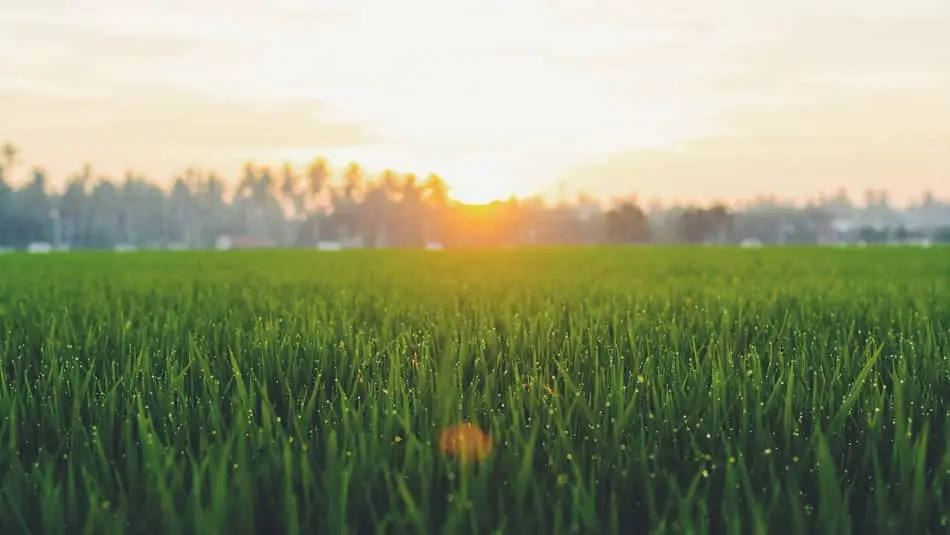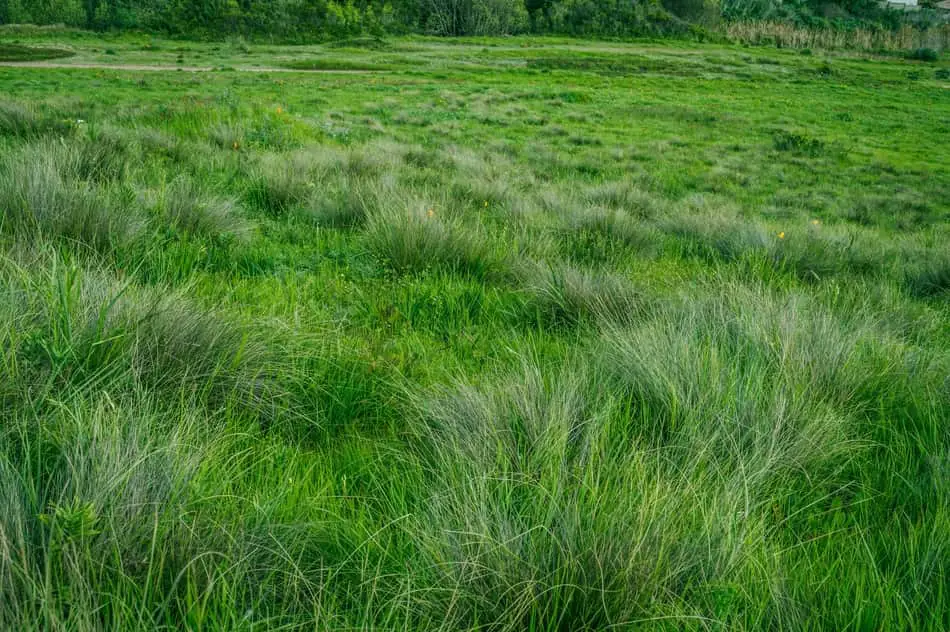
The old saying goes that the grass is always greener on the other side. We perceive other pastures as better than our own at the current time. It is certainly more desirable to have a lush green lawn than something pale and yellowing. But, this all leads to an interesting scientific question: is grass really green?
The answer is fortunately simple: When it’s healthy, grass is typically green. There are situations where grass can be not green, but the majority of the grass most people see is green. Things that might impact the colors of grass can include the health of the grass, other pigments in that variety, the stage of their lifecycle, or the season of the year. You might say of course grass is green because we can plainly see that. But, there is more to the color of grass than what our brains immediately perceive. It helps to know why our eyes register things as green, how this relates to the physiology of plants, and why other grasses aren’t green.
Let’s take a look at why grass actually is green.
What People See As Green.
To better understand why grass is or isn’t green, we need to know why we see anything as green. We know from basic color theory at school that to paint something green we need a blend of yellow and blue pigment. We blend them together in different ratios to create various tones and add color to white backgrounds. Color perception, however, is a little more complex than an artist mixing paint.
There are lots of different wavelengths of colored light within white light. All of these wavelengths are invisible to the naked eye when combined in white light, but we can use specialist equipment to see in infrared and ultraviolet.
Light beams out from its source, such as sunlight, and hits the surface of an object. We then see color based on the type of light reflected from that surface. If all wavelengths are reflected back towards the eye we see a white surface and if all the waves are absorbed then nothing comes back and we see black.
What this means is that when just a single wavelength is reflected back we can see that color. When the green light is reflected back from an object but the other colors are absorbed, we see things as green. Of course there are cases of color-blindness where this perception of green isn’t as it should be, but the majority of people will see naturally green things as green. This means that most of us will see grass as green.

Why Is Grass Green?
The main reason that grass is green is the presence of chlorophyll. It is this chemical within the plant that creates the green color by reflecting green light. Each cell can create chlorophyll and when this happens on a microscopic level, we see this as a uniform green color across the plant.
Chlorophyll is essential for the life of plants as it absorbs energy from the sun. Each healthy cell with active chlorophyll basically acts as a solar panel. It absorbs the energy from the sun and turns that into fuel for the plant. With water and additional nutrients from the soil, plans can thrive. This is why you also see green leaves on all kinds of other plants and trees, not just grasses.
Chlorophyll is a good indicator that a plant is healthy because of this process of generating energy. This is why lush green grass with a strong green tone is deemed healthier and more desirable – there is simply more chlorophyll in the leaves to reflect green light back to our eyes. If you have a patch of grass looking pale or a plant not as green as it should be, you may just need to provide more access to light.
On that note, did you also know that it is the high vitamin and antioxidant levels of chlorophyll that make “super green” smoothies and health drinks so beneficial? It isn’t just plants that benefit from this stuff!

The Different Colors of Grass.
The next big question here is why aren’t all grasses green if this green pigment is so important for their survival. Why aren’t all grasses green? There are different factors that can influence the way that we see the color of grass. They are:
- A lack of chlorophyll in the leaves which leads to a change in color
- The presence of other dominant pigments in the grasses
- The way that flower heads can affect the look of a lawn or field of grass.
Normally green grasses can change color because of a lack of chlorophyll. In some cases, the loss of pigment to a browner color denotes a sick or dying plant in need of attention. Sunlight-starved lawns tend to go pale and yellow. In other cases, the grasses could change color for the winter, much like trees. Some beautiful varieties turn blood red.
Then there are the times when you will find additional pigments in the leaves of ornamental grasses. A lot of popular grasses are much darker in tone, with purples verging on black. This doesn’t mean that there isn’t green chlorophyll in there working hard to feed the plant – we just can’t perceive it because of the way those darker pigments absorb the light.
Finally, there is the issue of perception when looking at a wide area of flowering grass. Small flowers or other plants or weeds dotted among the leaves can give the impression of a different tone. This leads us to another common question about green grass: why is Kentucky bluegrass not blue? A lot of people understandably expect bluegrass to appear to be more blue than it is – but the name comes from the flower, not the leaves! Although normally a rich emerald green, a carpet of flowering bluegrass will look more blue than your standard lawn.
Is Grass Really Green?
In short, grass is typically green when healthy because of the levels of chlorophyll providing energy for the plant. This reflects green light while absorbing other colors, and that green light bounces back to our eyes. A loss of chlorophyll means less reflected light and a difference in how we perceive the color. But, we can’t overlook other forms of grass that are red in the winter or dark purple all year. Take care of your grass to ensure it stays vibrant and healthy, whether green, blue, or any other color.

